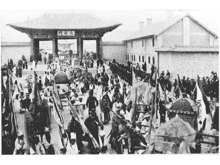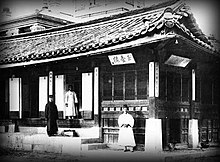Later years[edit]
Both began to grow affections for each other during their later years. Gojong was pressured by his advisers to take control of the government and administer his nation. However, one has to remember that Gojong was not chosen to become King because of his acumen (which he lacked because he was never formally educated) or because of his bloodline (which was mixed with courtesan and common blood), but because the Pungyang Jo clan had falsely assumed they could control the boy through his father. When it was actually time for Gojong to assume his responsibilities of the state, he often needed the aid of his wife to conduct international and domestic affairs. In this, Gojong grew an admiration for his wife's wit, intelligence, and ability to learn quickly. As the problems of the kingdom grew bigger and bigger, Gojong relied even more on his wife, she becoming his rock during times of frustration.
During the years of modernization of Joseon, it is safe to assume that Gojong was finally in love with his wife. They began to spend much time with each other, privately and officially. They shared each other's problems, celebrated each other's joys, and felt each other's pains. They finally became husband and wife.
His affection for her was undying, and it has been noted that after the death of his Queen Consort, Gojong locked himself up in his chambers for several weeks, refusing to assume his duties. When he finally did, he lost the will to even try and signed treaty after treaty that was proposed by the Japanese, giving the Japanese immense power. When his father regained political power after the death of his daughter-in-law, he presented a proposal with the aid of certain Japanese officials to lower his daughter-in-law's status as Queen Consort all the way to commoner posthumously. Gojong, a man who had always been used by others and never used his own voice for his own causes, was noted by scholars as having said, "I would rather slit my wrists and let them bleed than disgrace the woman who saved this kingdom." In an act of defiance, he refused to sign his father's and the Japanese proposal, and turned them away.
Assassination[edit]
Queen Min's assassination, known in Korea as the Eulmi Incident (을미사변, 乙未事變), occurred in the early hours of 8 October 1895 at Okho-ru (옥호루, 玉壺樓) in the Geoncheonggung (건청궁, 乾淸宮), which was the rear private royal residence inside Gyeongbokgung Palace.[22]
In the early hours of 8 October, Japanese agents under Miura Goro carried out the assassination. Miura had orchestrated this incident with Okamoto Ryūnosuke (岡本柳之助), Sugimura Fukashi (杉村 濬), Kunitomo Shigeaki (國友重章), Sase Kumatetsu (佐瀨熊鐵), Nakamura Tateo (中村楯雄), Hirayama Iwahiko (平山岩彦), and over fifty other Japanese men. Said to have collaborated in this were the pro-Japanese officers Lieutenant Colonel Woo Beom-seon (우범선, 禹範善) and Lieutenant Colonel Yi Du-hwang (이두황, 李斗璜) both battalion commanders in the "Hullyeondae," a Japanese trained Regiment of the Royal Guards.[22] The 1,000 Korean soldiers of the Hullyeondae, led by Lieutenant Colonel Woo Beom-seon[23] and Lieutenant Colonel Yi Du-hwang had surrounded and opened the gates of the palace, allowing a group of Japanese ronin to enter the inner sanctum.
In front of Gwanghwamun, the Hullyeondae soldiers led by Woo Beom-seon[23] battled the Korean Royal Guards led by Hong Gye-hun (홍계훈, 洪啓薰) and An Gyeong-su (안경수, 安駉壽).[22] Hong Gye-hun and Minister Yi Gyeong-jik (이경직, 李耕稙) were subsequently killed in battle, allowing the ronin assassins to proceed to Okhoru (옥호루, 玉壺樓), within Geoncheonggung, and kill the Empress. The corpse of the Empress was then burned and buried.[22]
Historian of Japan Peter Duus has called this assassination a "hideous event, crudely conceived and brutally executed."[24] Donald Keene, who calls the queen "an arrogant and corrupt woman", says that the way in which she was murdered was nonetheless "unspeakably barbaric."[25]
An eye-witness account[edit]
Crown Prince Sunjong reported that he saw Korean troops led by Woo Beom-seon at the site of the assassination, and accused Woo as the "Foe of Mother". In addition to his accusation, Sunjong sent two assassins to kill Woo, an effort that succeeded in Hiroshima, Japan, in 1903. By then, Woo had married a Japanese woman, and had sired Woo Jang-choon (禹長春 우장춘), later to become an acclaimed botanist and agricultural scientist.
In 2005, professor Kim Rekho (김려춘; 金麗春) of the Russian Academy of Sciences came across a written account of the incident by a Russian architect Afanasy Seredin-Sabatin (Афанасий Иванович Середин-Сабатин) in the Archive of Foreign Policy of the Russian Empire (Архив внешней политики Российской империи; AVPRI).[26] Seredin-Sabatin was in the service of the Korean government, working with the American general William McEntyre Dye who was also under contract to the Korean government. In April, Kim made a request to the Myongji University (명지대학교; 明知大學校) Library LG Collection to make the document public. On 11 May 2005 the document was made public.
Almost five years before the document's release in South Korea, a translated copy was in circulation in the United States, having been released by the Center for Korean Research of Columbia University on 6 October 1995 to commemorate the 100th anniversary of the Eulmi Incident.[27]
In the account, Seredin-Sabatin recorded:



No comments:
Post a Comment